Loved by reptile enthusiasts for their colorful bodies, large spines and dinosaur-like appearance, the Green Iguana is one of the most popular reptile species.
Iguanas are also some of the smartest and most affectionate Lizards with an ability to form social bonds.
These scaly giants are naturally found throughout the tropical of the rainforests of South and Central America, but are now invasive in Texas and Florida.
Known to grow as large as to 5-6 feet long and 11-20 pounds, these Lizards are giant-sized!
If Green Iguanas have piqued your interest, read on to learn how to make caring for them the best part of your day…
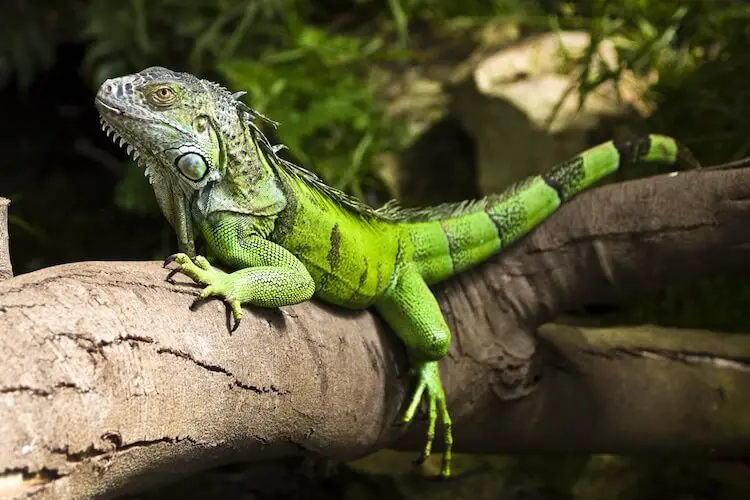
Green Iguana Overview
The Iguana can be found in many different habitats and countries, including the rainforests of northern Mexico, Central America, the Caribbean, and southern Brazil and Paraguay.
Often found in the trees, these hardy Lizards have been known to fall from trees and survive!
Their incredible ability to adapt, and hardy temperament, has allowed them to invade various parts of the Americas, including: Florida, Texas and the Virgin Islands.
Iguanas can be a multitude of bright colors (e.g. Green, Red, Blue, Yellow, White, Black, and Orange). Selective breeding and locality will impact their appearance significantly.
This species can grow to be 5-6 feet long. They have long spines that run down the length of their body and tail, a large flap of neck skin (i.e. a dewlap), golden-yellow eyes, and long claws.
Surprisingly, these reptilian giants are completely herbivorous.
They are known to eat a huge variety of plants in the wild.
What We Like About Green Iguanas
Pros:
- This species is also called “gallino de palo” or “bamboo chicken” in their native countries.
- They have a “third eye,” a photosensory organ on top of their head.
- Iguanas have facial recognition. This means they can learn who takes care of them.
- Hatchlings will stick together for up to a year. Males often protect females within the family group, a phenomenon not seen in other reptiles.
Cons:
- Iguanas require large, complex enclosures with plenty of perches and space.
- This lizard has specific temperature and lighting needs.
- They can take months to be socialized to human interaction.
- Males may show increased aggression during breeding seasons.
Species Appearance
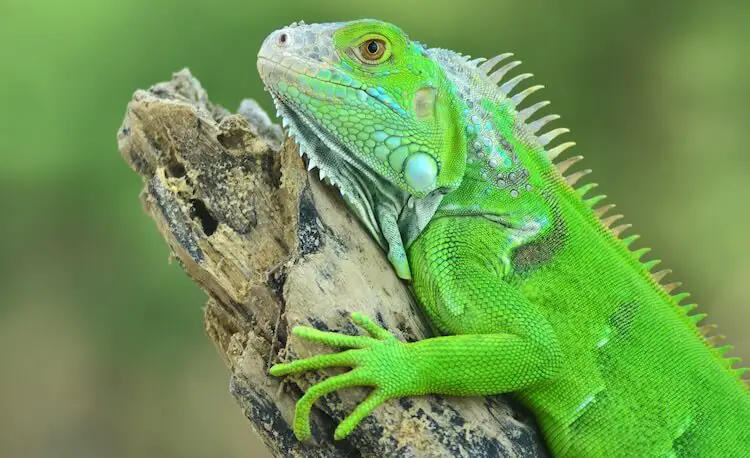
Green Iguanas show some signs of sexual dimorphism, though it is not exaggerated.
Males have prominent femoral pores underneath their back legs to spread pheromones. Females have these, but they are much smaller and not used.
In addition, males tend to be larger in size, with females rarely exceeding 5 feet in length. Males have longer, thicker dorsal spines and crests on their head and backs.
Green Iguana Size
A full grown Green Iguana will reach upwards of 6.6 feet in length. Females, from nose to tail, rarely exceed five feet in length and are on the lighter end of the weight spectrum of 11-20 pounds when compared with males.
Hatchlings show little size difference between the sexes. They hatch at 2.5 to 3.5 inches long (from snout to vent) and weigh approximately 3.5 to 4 ounces.
Juveniles are generally 1 to 3 years old. In that time, they grow to be 12-14 inches long and ~1.5 pounds in weight.
Color Variations and Markings
Though the name suggests that Green Iguanas are only green, this is not true.
They can actually be a variety of different colors. Iguanas can be purchased in: red, blue, green, yellow, white, black, and orange.
Typically, their price increases as their color becomes rarer (e.g. yellow, white, and black).
Locality and selective breeding impacts color significantly.
Like most lizards, they shed in pieces continually. This process can be helped with regular soaking, but normally they are able to remove the skin on their own when properly hydrated.
Green Iguana Cage Requirements
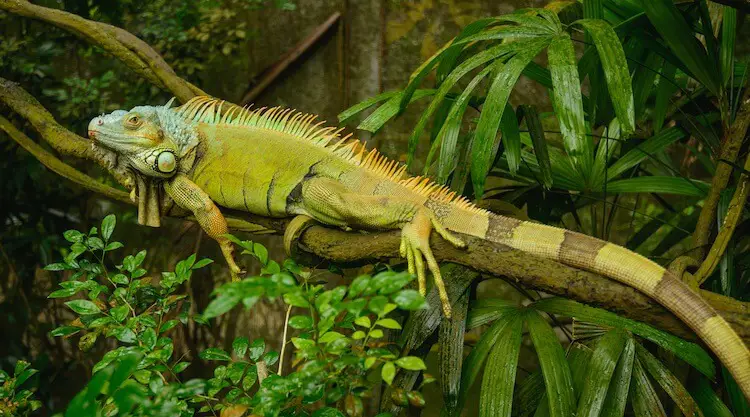
Found in tropical rainforests throughout South and Central America, these dinosaurs dominate the treetops. Green Iguanas are excellent climbers and swimmers.
They love high temperatures and humidity.
This species is known for spending most of their time basking in the canopy, but are always close to water. Their tank should replicate this.
Green Iguana Cage Size & Set Up
To calculate the correct cage-size for your Iguana, you should base it off their physical size. First measure your Iguana’s length. Their cage should be double this length long, the same width wide and six feet tall:
- Tank Type: custom screen or wooden vision cages.
- Tank Size: 4ft x 6ft x 6ft minimum.
- Lighting: UVB required.
- Substrate: Cypress mulch or topsoil for adults.
Cage-height is very important for your lizard.
Be sure to add plenty of climbing surfaces and thick branches, logs, and wooden platforms to create a natural arboreal home.
Iguanas are typically housed in either custom screen or wooden vision cages:
- Iguanas over 1.5 feet long should be moved to a larger terrarium or enclosure. The minimum sized-cage for adults is 4ft x 6ft x 6ft.
- Hatchlings are best kept in 20 gallon terrariums with screen tops. The small size ensures they easily find their food and water.
Some owners allow their Iguana to roam the house. While it does provide them space, this is often discouraged because of their tendency to climb furniture and become injured.
Basking is extremely important for the health of your lizard.
A basking spot of 100°F-115°F should be made in their cage. A 75 to100-watt bulb should be placed 12-18 inches above a rock on one end of the enclosure to create a suitable basking area. You can set the bulb to a cycle to mimic the day-night cycle.
Larger habitats may require up to six heating fixtures (e.g. infrared bulbs or ceramic heat emitters) to ensure the basking area is large enough to heat your Iguana’s whole body.
Their tank should also have a cool side of 80°F-85°F.
Avoid any type of belly heater or heat pads as they can burn your lizard. Because Iguanas thermoregulate with the help of their third eye, they fail to notice heat underneath them. In large enclosures, low wattage heaters should be used.
Having a hot and cool side in your enclosure allows your Iguana to thermoregulate.
Once you have suitable heating and lighting elements, you will want to choose a good substrate.
The age of your Green Iguana is important in deciding the type of substrate:
- Hatchling and juveniles sometimes eat substrate. The best option is to use either paper towels or newspaper.
- Adults normally live happily on cypress mulch, coconut fiber bedding, or organic topsoil. If you choose soil, make sure it is perlite-free.
Finally, add live plants like hibiscus for enrichment and grazing.
Any added plants should first be thoroughly rinsed and placed in the sun for 10-14 days to help remove any pesticides.
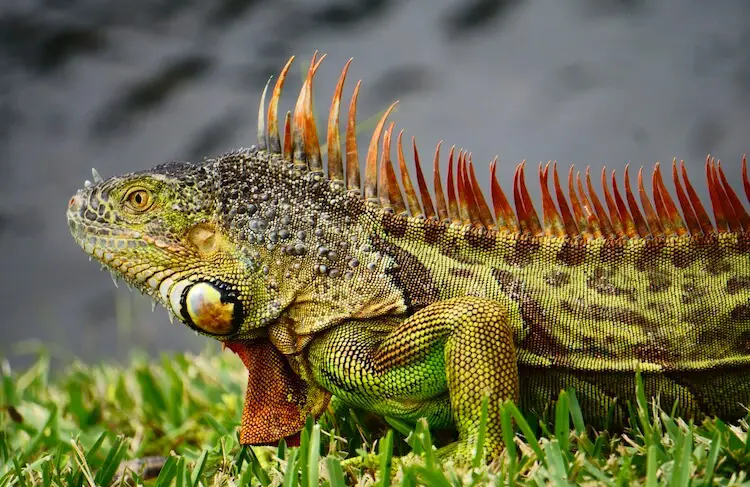
Cleaning & Misting
Green Iguanas eat a lot, so they will make large messes in their cage. Because of this, you should use a substrate shovel to remove feces and plant debris daily.
You should also use this time to inspect their feces.
Make sure it is a mix of dark feces and light urates. An imbalance of the two or absence entirely can indicate digestive issues.
Every four weeks, you should clean your Iguana’s cage and change the substrate entirely. If live plants are used, carefully remove them while keeping the root system intact.
All surfaces should be scrubbed with soap and water.
Any décor that can be removed should also be soaked in a 10% bleach bath to kill bacteria.
Green Iguana Care
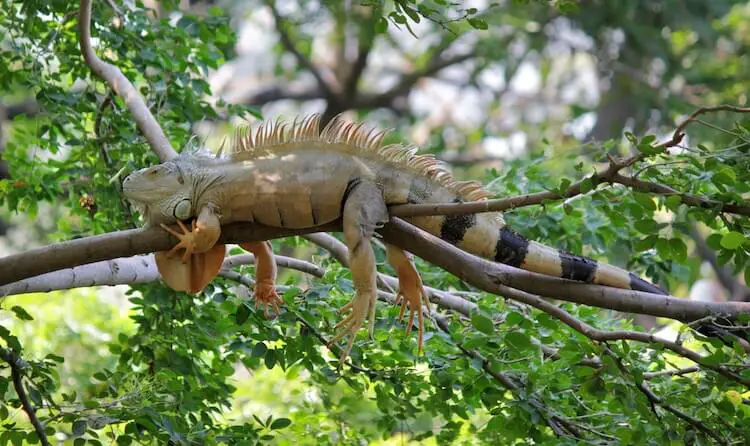
Green Iguana Diet
Because this species is an avid climber, they have a higher metabolism than many other reptiles. They often graze throughout the day to maintain energy levels.
In the wild, Iguanas are completely herbivorous. They consume a large variety of plants and flowers.
A Green Iguana’s diet is easy to cater for in captivity. Almost everything they eat can be found in your local supermarket.
All ages of Iguana should be fed 1-2 times daily. If your Iguana eats their salad quickly, or isn’t maintaining a consistent or growing weight, consider serving larger portions.
You should feed your iguana a variety of light and dark leafy greens:
- Black Mustard Seed.
- Broccoli (sparingly).
- Collards.
- Kale (sparingly).
- Romaine lettuce.
They also obtain nutrients from various vegetables like squashes, carrots, and green beans. They also love fruits, but should only be fed them 1-2 times a week to avoid diarrhea.
Food should be cut small enough for your Iguana to swallow whole. For harder vegetables like carrots and squash, you can use a cheese grater to shred over their greens.
In addition to plant variety, you should supplement their meals with vitamins.
A multivitamin and calcium supplement can be sprinkled over their salad three times a week as juveniles and twice as adults.
It is important to avoid certain foods for your Iguana:
- Iceberg lettuce has no nutrient value.
- Spinach, parsley, and other foods high in oxalates can cause calcium binding.
- Proteins should be avoided, they are directly linked to renal failure in adult iguanas.
Finally, Iguanas require large amounts of water to maintain hydration.
Hatchlings and juveniles rarely drink water from a dish. They should be misted daily and soaked 2-3 times per week.
Adults should be given a dish large enough to sit in and should continue to be misted daily.
Green Iguana Lifespan & Health

Iguanas typically live 15-25 years in captivity. Correct and consistent husbandry will help to increase their lifespan.
Common health issues that may occur in this species are:
- Egg retention.
- Parasites.
- Kidney disease.
- Metabolic bone disease.
- Anorexia (caused by low temperatures).
- Mouth rot.
Egg retention and metabolic bone disease are both caused by improper lighting and nutrition. These issues can be prevented with correct nutrition and UVB lighting.
Parasites can be diagnosed through a fecal exam. It is easily treated with prescription medication.
If you suspect your reptile is sick, always seek veterinary advice.
Signs They Are Healthy:
- Climbing frequently.
- Eating their salads daily.
- Basking regularly.
- Defecating every 1-2 days.
Sickness Symptoms:
- Staying on the ground.
- Lack of appetite.
- Loose, wrinkly skin that doesn’t hold shape.
- Constipation.
Typical Behavior
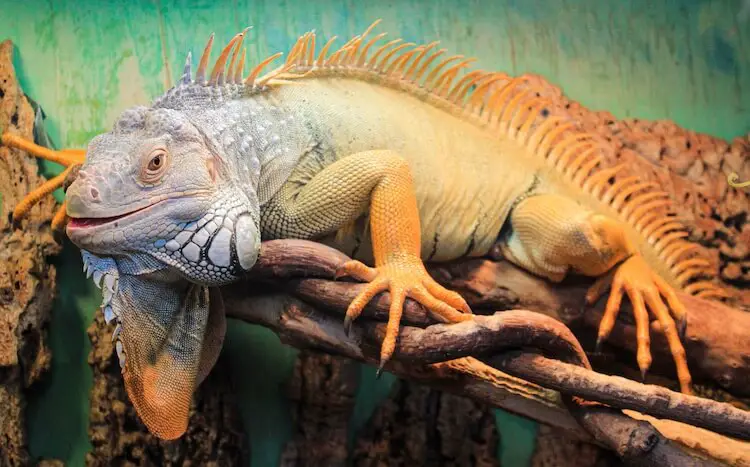
Green Iguanas are diurnal, meaning they are active during the day. They spend the majority of their time in the trees and also enjoy swimming.
Your Lizard should be seen basking most often during the day.
They rarely stay on the ground, so make sure they have plenty of climbing material and are using it in their cage. If they are burrowing or spending too much time on the ground, check your temperatures.
As hatchlings, they stick together in family groups for up to a year. Males will defend the females from predators during this time.
After their first year, they begin to lead solitary lifestyles. Adults typically only interact when fighting for territory or mating. Males may attack females outside of the breeding season, though it is less common than male fights.
Green Iguanas communicate with other species through complex visual cues. Males typically show dominant behaviors through visual displays:
- Bobbing their heads.
- Extending their dewlap.
- Puffing up their bodies.
- Biting or tail whipping when they feel threatened or challenged.
- They may hiss
Males tend to become hyper aggressive during breeding periods
A normally calm lizard may suddenly become fearful or hostile. They will eventually calm down after their hormones decrease, but handling should be done carefully and sparingly during the breeding season.
When this species is stressed, they often attempt to flee.
Captive Green Iguanas that feel threatened will often rub their noses frantically along the edge of their cage, sometimes until it is bleeding. If you notice this, it may be necessary to increase their tank size and add more enrichment and contact vet if wounded.
Handling
In captivity, if you practice slow socialization from a young age, a Green Iguana can be docile and calm.
However, if they haven’t been socialized, or are with a stranger, they may exhibit defensive behaviors of hissing, biting, clawing, tail whipping, and stiffening.
Green Iguanas can be stressed out as hatchlings.
Excessive handling can amplify this and make it harder to socialize.
After putting your Iguana in their new enclosure, avoid handling. Instead, try moving décor around in the cage to get them used to you.
You should start handling them by feeding them with your hands. They will start to trust you once they associate you with feeding.
Once trust is built, you can start handling. This process can take months for some species.
Green Iguanas have long, whipping tails, large claws, and razor-sharp teeth.
When handling a larger Lizard, consider techniques to help you avoid danger zones:
- Point their face away from yours
- Keep their tail pointed towards the ground behind you
- Brace their weight by placing your hand between their forelimbs
Baby Green Iguanas
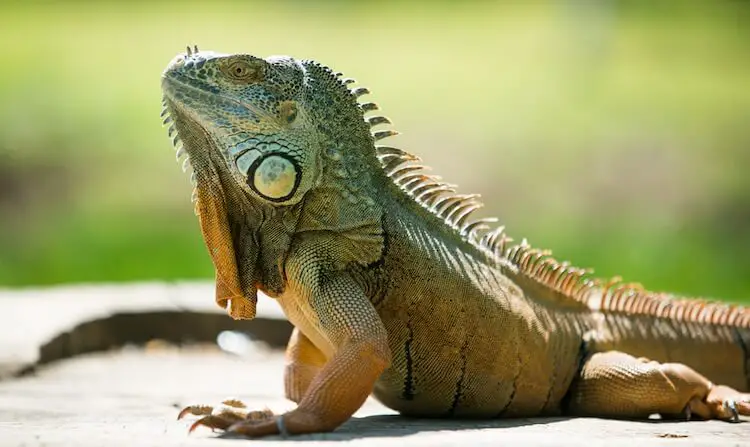
This lizard typically reaches sexual maturity between three and four years old. Breeding will occur during the dry season, making sure that hatchlings emerge in time for the wet season.
Courtship involves one or more females gathering in a territory where they can be near males. Several males will be attracted and may even fight.
Females typically lay 20-70 eggs each annual breeding cycle. They will bury their eggs in a burrow and then abandon them.
Ten to 15 weeks later, Baby Green Iguanas will emerge in search of food and shelter as a group.
Their care is very similar to adults. The main differences are that they should be housed in a 20-gallon terrarium and substrate should be limited to paper towels or newspaper.
Buyer’s Guide
Baby Green Iguanas are typically priced between $20-$75 USD. This depends largely on their coloration.
Rare colorations (e.g. yellow, white, and black) can cost hundreds of dollars and adults are upwards of $150 USD.
This lizard can be purchased from local pet stores. However, make sure they are not wild-caught, as they tend to have diseases and behavioral issues.
There are dozens of Iguanas rescues centers, so adoption is always a choice.
Green Iguana Facts
| Vital Facts | |
|---|---|
| Common Name | Iguana |
| Scientific Name | Iguana iguana |
| Price | ~$75 |
| Size | 4-6 feet long |
| Lifespan | 15 to 30 years |
| Diet | Variety of leafy greens, vegetables, and fruit |
| Tank Size | Minimum 6ftx4ftx6ft |
| Humidity & Temperature | Daytime temperature: 80°F-85°F Basking Spot: 100°F-115°F Humidity: 60 to 70% |
| Popular Alternatives | Rhinoceros Iguana, Tegu, Nile Monitor |
Summary
The Green Iguana can be moderately difficult to care for due to their socialization issues, large size, and arboreal nature.
Many owners overcome these issues by building strong, positive relationships with their Iguanas using food; it just takes time and patience.
With correct and consistent husbandry, these dinosaur-like Lizards can live to be 15-30 years old and grow over 5-6 feet in length.
If the Green Iguana requires too much husbandry, similar species which require less work include the Tegu, some Monitor species, and the Rhinoceros Iguanas:
- Tegus and Monitors are carnivores, but they grow to be of similar size and normally don’t require climbing materials.
- Rhino Iguanas are fairly similar in care, but just have a smaller adult size.
Do you think the Green Iguana will make a great addition to your home?
Let us know in the comments!



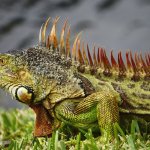

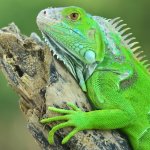



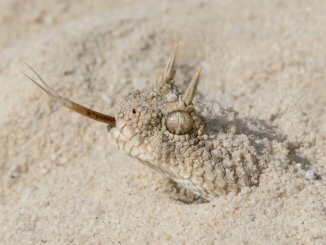
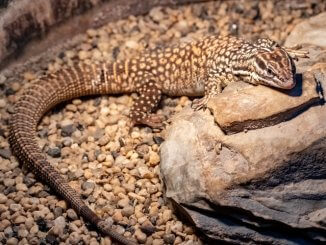
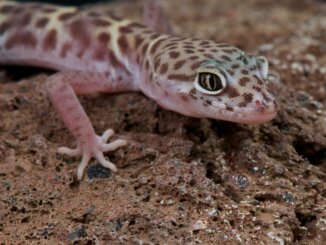

I have always loved seeing Green Iguanas chill out in enclosures and out in nature. I just love the green on some of the individuals, along with the orange/red spines!
Hello, we rescued an Iguana in rough conditions. Now we built a temporary shelter, then a nice enclosure with trees and a pool.
I would like to know what kind of iguana it is and how to care for this mistreated animal. We have a lot of kids around (Kindergarden), will that be a problem for him?
We can send you some photos to identify.
Any advice is very welcome, thank you.
It can be, but in my experience if you teach kids how to treat the animal with respect you won’t have a problem. This includes the usual not pulling the tail, not picking him up out of the blue, no shouting at him in his face and other obvious rules. I don’t know how big the iguana is, but this could easily turn into a problem for the kids too, because an iguana can easily react and bite/scratch someone’s finger. As for identification please comment on here with your email and I will send you mine! Thanks, hope this helps
My son has a green 6 ft iguana. I pet sit it for few yrs. In summer I clean his swim pool and feed him greens he loves cherry tomatoes carrots and blueberries and watermelon. Kale mustard greens. He spends summer in a revamped chicken coop. At night he sits on 2small logs
Under his lamp. We are close friends he acknowledged me by shacking his head and I pet him.
That is one sweet little story for one fierce giant iguana! 6 ft?! Wondering how many blueberries it takes to feed him and I would love to see the revamped chicken coop. Anyway, glad you read us!